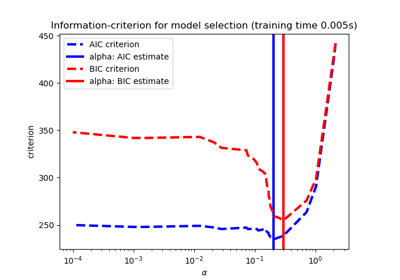3.2.4.2.1. sklearn.linear_model.LassoLarsIC¶
-
class
sklearn.linear_model.LassoLarsIC(criterion='aic', *, fit_intercept=True, verbose=False, normalize=True, precompute='auto', max_iter=500, eps=2.220446049250313e-16, copy_X=True, positive=False)[source]¶ Lasso model fit with Lars using BIC or AIC for model selection
The optimization objective for Lasso is:
(1 / (2 * n_samples)) * ||y - Xw||^2_2 + alpha * ||w||_1
AIC is the Akaike information criterion and BIC is the Bayes Information criterion. Such criteria are useful to select the value of the regularization parameter by making a trade-off between the goodness of fit and the complexity of the model. A good model should explain well the data while being simple.
Read more in the User Guide.
- Parameters
- criterion{‘bic’ , ‘aic’}, default=’aic’
The type of criterion to use.
- fit_interceptbool, default=True
whether to calculate the intercept for this model. If set to false, no intercept will be used in calculations (i.e. data is expected to be centered).
- verbosebool or int, default=False
Sets the verbosity amount
- normalizebool, default=True
This parameter is ignored when
fit_interceptis set to False. If True, the regressors X will be normalized before regression by subtracting the mean and dividing by the l2-norm. If you wish to standardize, please usesklearn.preprocessing.StandardScalerbefore callingfiton an estimator withnormalize=False.- precomputebool, ‘auto’ or array-like, default=’auto’
Whether to use a precomputed Gram matrix to speed up calculations. If set to
'auto'let us decide. The Gram matrix can also be passed as argument.- max_iterint, default=500
Maximum number of iterations to perform. Can be used for early stopping.
- epsfloat, optional
The machine-precision regularization in the computation of the Cholesky diagonal factors. Increase this for very ill-conditioned systems. Unlike the
tolparameter in some iterative optimization-based algorithms, this parameter does not control the tolerance of the optimization. By default,np.finfo(np.float).epsis used- copy_Xbool, default=True
If True, X will be copied; else, it may be overwritten.
- positivebool, default=False
Restrict coefficients to be >= 0. Be aware that you might want to remove fit_intercept which is set True by default. Under the positive restriction the model coefficients do not converge to the ordinary-least-squares solution for small values of alpha. Only coefficients up to the smallest alpha value (
alphas_[alphas_ > 0.].min()when fit_path=True) reached by the stepwise Lars-Lasso algorithm are typically in congruence with the solution of the coordinate descent Lasso estimator. As a consequence using LassoLarsIC only makes sense for problems where a sparse solution is expected and/or reached.
- Attributes
- coef_array-like of shape (n_features,)
parameter vector (w in the formulation formula)
- intercept_float
independent term in decision function.
- alpha_float
the alpha parameter chosen by the information criterion
- n_iter_int
number of iterations run by lars_path to find the grid of alphas.
- criterion_array-like of shape (n_alphas,)
The value of the information criteria (‘aic’, ‘bic’) across all alphas. The alpha which has the smallest information criterion is chosen. This value is larger by a factor of
n_samplescompared to Eqns. 2.15 and 2.16 in (Zou et al, 2007).
See also
Notes
The estimation of the number of degrees of freedom is given by:
“On the degrees of freedom of the lasso” Hui Zou, Trevor Hastie, and Robert Tibshirani Ann. Statist. Volume 35, Number 5 (2007), 2173-2192.
https://en.wikipedia.org/wiki/Akaike_information_criterion https://en.wikipedia.org/wiki/Bayesian_information_criterion
Examples
>>> from sklearn import linear_model >>> reg = linear_model.LassoLarsIC(criterion='bic') >>> reg.fit([[-1, 1], [0, 0], [1, 1]], [-1.1111, 0, -1.1111]) LassoLarsIC(criterion='bic') >>> print(reg.coef_) [ 0. -1.11...]
Methods
fit(X, y[, copy_X])Fit the model using X, y as training data.
get_params([deep])Get parameters for this estimator.
predict(X)Predict using the linear model.
score(X, y[, sample_weight])Return the coefficient of determination R^2 of the prediction.
set_params(**params)Set the parameters of this estimator.
-
__init__(criterion='aic', *, fit_intercept=True, verbose=False, normalize=True, precompute='auto', max_iter=500, eps=2.220446049250313e-16, copy_X=True, positive=False)[source]¶ Initialize self. See help(type(self)) for accurate signature.
-
fit(X, y, copy_X=None)[source]¶ Fit the model using X, y as training data.
- Parameters
- Xarray-like of shape (n_samples, n_features)
training data.
- yarray-like of shape (n_samples,)
target values. Will be cast to X’s dtype if necessary
- copy_Xbool, default=None
If provided, this parameter will override the choice of copy_X made at instance creation. If
True, X will be copied; else, it may be overwritten.
- Returns
- selfobject
returns an instance of self.
-
get_params(deep=True)[source]¶ Get parameters for this estimator.
- Parameters
- deepbool, default=True
If True, will return the parameters for this estimator and contained subobjects that are estimators.
- Returns
- paramsmapping of string to any
Parameter names mapped to their values.
-
predict(X)[source]¶ Predict using the linear model.
- Parameters
- Xarray_like or sparse matrix, shape (n_samples, n_features)
Samples.
- Returns
- Carray, shape (n_samples,)
Returns predicted values.
-
score(X, y, sample_weight=None)[source]¶ Return the coefficient of determination R^2 of the prediction.
The coefficient R^2 is defined as (1 - u/v), where u is the residual sum of squares ((y_true - y_pred) ** 2).sum() and v is the total sum of squares ((y_true - y_true.mean()) ** 2).sum(). The best possible score is 1.0 and it can be negative (because the model can be arbitrarily worse). A constant model that always predicts the expected value of y, disregarding the input features, would get a R^2 score of 0.0.
- Parameters
- Xarray-like of shape (n_samples, n_features)
Test samples. For some estimators this may be a precomputed kernel matrix or a list of generic objects instead, shape = (n_samples, n_samples_fitted), where n_samples_fitted is the number of samples used in the fitting for the estimator.
- yarray-like of shape (n_samples,) or (n_samples, n_outputs)
True values for X.
- sample_weightarray-like of shape (n_samples,), default=None
Sample weights.
- Returns
- scorefloat
R^2 of self.predict(X) wrt. y.
Notes
The R2 score used when calling
scoreon a regressor usesmultioutput='uniform_average'from version 0.23 to keep consistent with default value ofr2_score. This influences thescoremethod of all the multioutput regressors (except forMultiOutputRegressor).
-
set_params(**params)[source]¶ Set the parameters of this estimator.
The method works on simple estimators as well as on nested objects (such as pipelines). The latter have parameters of the form
<component>__<parameter>so that it’s possible to update each component of a nested object.- Parameters
- **paramsdict
Estimator parameters.
- Returns
- selfobject
Estimator instance.

